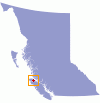The water holds great day excursions in and around the meandering littoral zones of Side Bay, Gooding Cove, Harvey Cove and Klaskino Inlet, which are all accessible by boat.
The heritage of the First Nations families who have resided in the area for many generations can be felt and has close ties to the community. Along with the early development of this well planned village, it creates a welcoming environment full of inspiration and natural sightseeing.
There are many conveniences; recreational facilities, yacht club, restaurants, small shops, camp and RV grounds, and basic services, which visitors can access directly in the village. While in the village notice the local works by the arts community. There are many artists within Port Alice who's talent is either a professional or part-time passion.
Population: 1,100+
Highlights:
Nissen Bight
Hansen Lagoon
Nels Bight
Experiment Bight
Salmon Hatcheries
Sand Neck
Guise Bay
Sauna Bay - great offshore fishing
Quatsino limestone formations - true wonder
Cape Scott - limited access
North Coast Trail - Cape Scott to Port Hardy, rugged coastal views, trail for experienced hikers
Things To Bring:
Take Caution: the forest regions of park lands around Port Alice are home to large wild animals such as bear and cougar. Talk loudly in groups or walk / hike with bells to forewarn these creatures of your presence.
Be aware also of campfire and tidal postings indicating the potential dangers.
History:
For thousands of years, the area of Port Alice was a shared terrain around Cape Scott between three native peoples; the Tlatlasikwala, Nakumgilisala and Yutlinuk. Numbers for each tribe dwindled during the 1800's, until eventually only the Nakumgilisala and the Tlatlasikwala remained and united on Hope Island. By the mid-1800's there were less than forty members and the group decided to join the Koskimo people. Now known as the Nahwitti the families live on six local reserves, two are near the boarder of the popular Provincial Park of Cape Scott.
Though Port Alice has since grown as a small marine community it originally took several attempts by the Danish and was a radar station during World War II. By design the community was built to replace an earlier attempt four kilometers further along the inlet. The village of Port Alice was well planned and named after a local woman Alice Whalen whose family were large contributors to the pulp mill industry which help the establish the community in its early years (early 1900's).
Climate:
Summer average 18 degrees Celsius
Winter average 3 degrees Celsius

